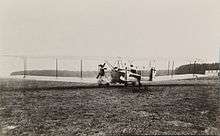AEG G.V
| AEG G.V | |
|---|---|
 | |
| Role | Bomber |
| National origin | |
| Manufacturer | AEG |
| Introduction | May 1918[1] |
| Primary users | Luftstreitkräfte Deutsche Luftreederei Swedish Air Force[1] |
| Produced | 1918 |
| Developed from | AEG G.IV |

The AEG G.V was a biplane bomber aircraft of World War I, a further refinement of the AEG G.IV. The type saw limited production before the Armistice, and never entered operational service. It featured a 600 kg (1,320 lb) bombload.[1]
After the war, several were converted into 6-passenger airliners. It was the only large German World War I aircraft to see commercial duties in any significant capacity. Initially, passengers sat in an open cockpit, but a Limousine version was soon developed. AEG attached a cabin fairing to enclose the passenger area and outfitted the nose with a hinged door for baggage. Finally, a toilet was provided aft of the passenger cabin.
Operators
Specifications (AEG G.V)
Data from German Aircraft of the First World War[1]
General characteristics
- Crew: 3 or 4
- Capacity: 6
- Length: 10.8 m (35 ft 5 in)
- Wingspan: 27.24 m (89 ft 4 in)
- Height: 4.5 m (14 ft 9 in)
- Wing area: 89.5 m2 (963 sq ft)
- Empty weight: 2,700 kg (5,952 lb)
- Gross weight: 4,600 kg (10,141 lb)
- Powerplant: 2 × Mercedes D.IVa 6-cyl. water-cooled in-line piston engine, 194 kW (260 hp) each
Performance
- Maximum speed: 145 km/h (90 mph; 78 kn)
- Ferry range: 1,160 km (721 mi; 626 nmi)
- Service ceiling: 6,500 m (21,325 ft)
- Rate of climb: 2.78 m/s (547 ft/min)
- Time to altitude: 1,000m (3,281ft) in 6min
Armament
- Guns: 2 or 3 manually operated 7.92 mm (.312 in) machine-guns
- Bombs: 600kg (1,300lb) of bombs
See also
- Related development
- Aircraft of comparable role, configuration and era
- Related lists
References
Further reading
| Wikimedia Commons has media related to AEG aircraft. |
- Kroschel, Günter; Stützer, Helmut: Die deutschen Militärflugzeuge 1910-18, Wilhelmshaven 1977
- Munson, Kenneth: Bomber 1914–19, Zürich 1968, Nr. 20
- Nowarra, Heinz: Die Entwicklung der Flugzeuge 1914-18, München 1959
- Sharpe, Michael: Doppeldecker, Dreifachdecker & Wasserflugzeuge, Gondrom, Bindlach 2001, ISBN 3-8112-1872-7